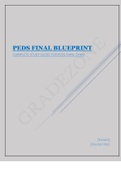PEDS FINAL BLUEPRINT
COMPLETE STUDY GUIDE FOR PEDS FIANL EXAM
[School]
[Course title]
,PEDS FINAL BLUEPRINT
GI facts about children
Variations in anatomy & physiology:
*Abnormal distention can cause respiratory distress in young children because the accessory
muscles of respiration are less developed and they are more dependent on the diaphragm as
the primary muscle of respiration
*Pancreatic amylase secretion does not begin until age 4 mos (avoid giving things like cereal too
early!!)
*Stomach capacity increases from 10-20mL in early infancy to up to 3 L by late adolescence
*The infant's intestine is highly permeable, allowing uptake of protective immunoglobulin from
human milk
*Stool frequency is highest in infancy and decreases to adult frequency by age 4 years
*Lower esophageal sphincter is not fully functioning until 1 month because of immature muscle
tone (so spit up city!!)
Focused GI history:
-presenting problem, weight loss, vomiting, spitting up (really note frequency on
this), bowel movements-normal pattern, diarrhea, constipation; abdominal pain; diet
hx; past med or surg hx of GI problems; family hx of GI problems *green stools is
associated with quick passage through intestines*
GI physical exam: Inspect & observe—
-Child’s color-skin, eyes, & lips
-Hydration status-oral mucosa, skin turgor, tears & urinary output
-Abdominal size and shape-measure abdominal girth. Should be flat when they’re -supine
(bulging could indicate ascites, tumor, gas, etc). A depressed or concave abdomen can indicate
some kind of obstruction or dehydration.
-Mental status-irritability, restlessness, lethargy, listlessness
GI physical exam assessment:
Auscultation-up to 5 minutes in all 4 quadrants=20 minutes (Immediately report hypoactive or
absent bowel sound findings to the physician or nurse practitioner.)
Percussion-liver: dullness normally at 1-3cm below right costal margin; full bladder: dullness
above symphysis pubis; tympany: normally heard throughout most of abdomen
Palpation-none if suspect Wilm’s tumor of course, light palpation…then deep. Helps if legs are
bent or knees are flexed.
common serum labs to evaluate GI status
, Sodium, potassium, chloride, CO2, BUN, creatinine (hydration status)
-Amylase, lipase (digestive function)
-LFTs-AST, ALT, GGT (liver function)
-Total protein & albumin (nutritional status overall)
labs from stool specimens
-Guaiac hemoccult: performed to check for occult blood
-Cultures
-Stool pH:
-O&P
-Quantitative fat
-Fecal reducing substance
-Review policy/procedure
-Preparation of child
Barium Diagnostic Procedures:
-Barium enema—lower GI series (before do bowel prep, teach about procedure; after-
hydration, monitor BMs)
-Barium swallow—upper GI series (patient drinks barium; NPO for certain amount of time prior
to test; conscious sedation; rarely need laxative after test)
***GI diagnostics: radiographs (x-rays), KUB; ultrasounds, CT scans, MRIs, motility studies (pH
study); biopsies
ostomy care
-CWOCN—aka wound care nurse who work with all children who have ostomies
-Patient may have body image issues
-Family acceptance is sometimes difficult
-Developmental issues with children pulling off ostomy bags
-Stoma should be pink color with no bleeding
-Maintain integrity of skin around stoma
-Type of ostomy bag needs to be documented
-Using a pacifier for infants while they’re getting a feeding through their tube will help
outcomes!
Nutritional therapy:
Breastmilk, infant formulas, modified oral diets; enteral nutrition: formulas, feeding methods
(continuous or intermittent/bolus); feeding tubes: OG, NG, NJ)
Dehydration:




